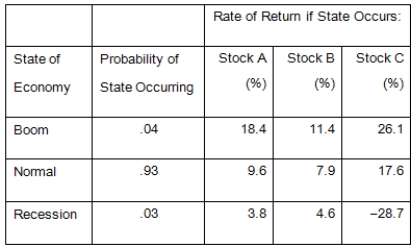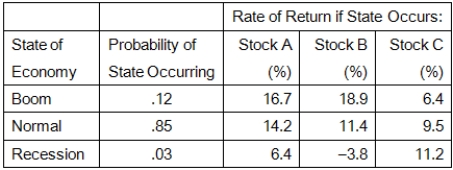A) 38 percent
B) 55 percent
C) 13 percent
D) 42 percent
E) 06 percent
Correct Answer

verified
Correct Answer
verified
Multiple Choice
Diversifying a portfolio across various sectors and industries might do more than one of the following.However,this diversification must do which one of the following?
A) Increase the expected risk premium
B) Reduce the beta of the portfolio to one
C) Increase the security's risk premium
D) Reduce the portfolio's systematic risk level
E) Reduce the portfolio's unique risks
Correct Answer

verified
Correct Answer
verified
Multiple Choice
Which term best refers to the practice of investing in a variety of diverse assets as a means of reducing risk?
A) Systematic
B) Unsystematic
C) Diversification
D) Security market line
E) Capital asset pricing model
Correct Answer

verified
Correct Answer
verified
Multiple Choice
Fiddler's Music Stores' stock has a risk premium of 8.3 percent while the inflation rate is 3.1 percent and the risk-free rate is 3.8 percent.What is the expected return on this stock?
A) 9.0 percent
B) 6.9 percent
C) 12.1 percent
D) 13.7 percent
E) 15.2 percent
Correct Answer

verified
Correct Answer
verified
Multiple Choice
The risk premium for an individual security is based on which one of the following types of risk?
A) Total
B) Surprise
C) Diversifiable
D) Systematic
E) Unsystematic
Correct Answer

verified
Correct Answer
verified
Multiple Choice
Stock A comprises 28 percent of Susan's portfolio.Which one of the following terms applies to the 28 percent?
A) Portfolio variance
B) Portfolio standard deviation
C) Portfolio weight
D) Portfolio expected return
E) Portfolio beta
Correct Answer

verified
C
Correct Answer
verified
Multiple Choice
Which one of the following is the best example of unsystematic risk?
A) Inflation exceeding market expectations
B) A warehouse fire
C) Decrease in corporate tax rates
D) Decrease in the value of the dollar
E) Increase in consumer spending
Correct Answer

verified
Correct Answer
verified
Multiple Choice
Southern Wear stock has an expected return of 15.1 percent.The stock is expected to lose 8 percent in a recession and earn 18 percent in a boom.The probabilities of a recession,a normal economy,and a boom are 2 percent,87 percent,and 11 percent,respectively.What is the expected return on this stock if the economy is normal?
A) 14.79 percent
B) 17.04 percent
C) 15.26 percent
D) 16.43 percent
E) 11.08 percent
Correct Answer

verified
Correct Answer
verified
Multiple Choice
Which one of the following best exemplifies unsystematic risk?
A) Unexpected economic collapse
B) Unexpected increase in interest rates
C) Unexpected increase in the variable costs for a firm
D) Sudden decrease in inflation
E) Expected increase in tax rates
Correct Answer

verified
Correct Answer
verified
Multiple Choice
The slope of the security market line represents the:
A) risk-free rate.
B) market risk premium.
C) beta coefficient.
D) risk premium on an individual asset.
E) market rate of return.
Correct Answer

verified
Correct Answer
verified
Multiple Choice
The security market line is defined as a positively sloped straight line that displays the relationship between the:
A) beta and standard deviation of a portfolio.
B) systematic and unsystematic risks of a security.
C) nominal and real rates of return.
D) expected return and beta of either a security or a portfolio.
E) risk premium and beta of a portfolio.
Correct Answer

verified
Correct Answer
verified
Multiple Choice
The expected rate of return on Delaware Shores stock is based on three possible states of the economy.These states are boom,normal,and recession which have probabilities of occurrence of 20 percent,75 percent,and 5 percent,respectively.Which one of the following statements is correct concerning the variance of the returns on this stock?
A) The variance must decrease if the probability of occurrence for a boom increases.
B) The variance will remain constant as long as the sum of the economic probabilities is 100 percent.
C) The variance can be positive, zero, or negative, depending on the expected rate of return assigned to each economic state.
D) The variance must be positive provided that each state of the economy produces a different expected rate of return.
E) The variance is independent of the economic probabilities of occurrence.
Correct Answer

verified
Correct Answer
verified
Multiple Choice
Which statement is correct?
A) A portfolio that contains at least 30 diverse individual securities will have a beta of 1.0.
B) Any portfolio that is correctly valued will have a beta of 1.0.
C) A portfolio that has a beta of 1.12 will lie to the left of the market portfolio on a security market line graph.
D) A risk-free security plots at the origin on a security market line graph.
E) An underpriced security will plot above the security market line.
Correct Answer

verified
Correct Answer
verified
Multiple Choice
Which statement is correct?
A) An underpriced security will plot below the security market line.
B) A security with a beta of 1.54 will plot on the security market line if it is correctly priced.
C) A portfolio with a beta of .93 will plot to the right of the overall market.
D) A security with a beta of .99 will plot above the security market line if it is correctly priced.
E) A risk-free security will plot at the origin.
Correct Answer

verified
Correct Answer
verified
Multiple Choice
Which one of the following statements is correct?
A) The risk premium on a risk-free security is generally considered to be one percent.
B) The expected rate of return on any security, given multiple states of the economy, must be positive.
C) There is an inverse relationship between the level of risk and the risk premium given a risky security.
D) If a risky security is correctly priced, its expected risk premium will be positive.
E) If a risky security is priced correctly, it will have an expected return equal to the risk-free rate.
Correct Answer

verified
Correct Answer
verified
Multiple Choice
Given the following information,what is the expected return on a portfolio that is invested 30 percent in both Stocks A and C,and 40 percent in Stock B? 
A) 11.08 percent
B) 12.94 percent
C) 12.33 percent
D) 10.84 percent
E) 10.42 percent
Correct Answer

verified
Correct Answer
verified
Multiple Choice
Given the following information,what is the standard deviation of the returns on a portfolio that is invested 40 percent in Stock A, 35 percent in Stock B, and the remainder in Stock C? 
A) 1.68 percent
B) 6.72 percent
C) 3.16 percent
D) 2.43 percent
E) 16.57 percent
Correct Answer

verified
Correct Answer
verified
Multiple Choice
Given the following information,what is the expected return on a portfolio that is invested 35 percent in Stock A, 45 percent in Stock B, and the balance in Stock C?

A) 12.04 percent
B) 12.16 percent
C) 12.91 percent
D) 13.46 percent
E) 11.87 percent
Correct Answer

verified
B
Correct Answer
verified
Multiple Choice
Julie wants to create a $5,000 portfolio.She also wants to invest as much as possible in a high risk stock with the hope of earning a high rate of return.However,she wants her portfolio to have no more risk than the overall market.Which one of the following portfolios is most apt to meet all of her objectives?
A) Invest the entire $5,000 in a stock with a beta of 1.0
B) Invest $2,500 in a stock with a beta of 1.98 and $2,500 in a stock with a beta of 1.0
C) Invest $2,500 in a risk-free asset and $2,500 in a stock with a beta of 2.0
D) Invest $2,500 in a stock with a beta of 1.0, $1,250 in a risk-free asset, and $1,250 in a stock with a beta of 2.0
E) Invest $2,000 in a stock with a beta of 3, $2,000 in a risk-free asset, and $1,000 in a stock with a beta of 1.0
Correct Answer

verified
Correct Answer
verified
Multiple Choice
Systematic risk is:
A) totally eliminated when a portfolio is fully diversified.
B) defined as the total risk associated with surprise events.
C) risk that affects a limited number of securities.
D) measured by beta.
E) measured by standard deviation.
Correct Answer

verified
D
Correct Answer
verified
Showing 1 - 20 of 39
Related Exams